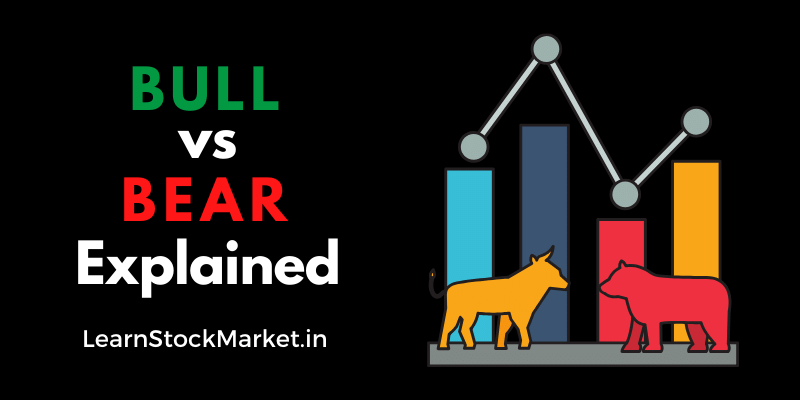Wealth is created when you invest in the bear market and exit in the bull market.
Very easy to say, very difficult to do!
Timing the market is extremely difficult. If you buy when the NIFTY has crashed from 12000 to 8000, it could go further down to 6000 or even 4000.
If you sell when the NIFTY goes to 12000, it could go to 20000 or 25000.
In the stock market, there is no limit on both sides.
Between 2003 to 2007, the NIFTY went from 950 to 6200. That’s a rise of nearly 6-7 times. It’s like the current NIFTY going from 10000 to 70000!
Many stocks during this period gave returns of 50-100 times!
In 2008, the NIFTY was at 6200 in January, it crashed to a low of 2500 in November. That’s a crash of 60%.
Many stocks during this period crashed by 80-90%. Even the best of companies fell by 50% or more.
The market is always about extremes on both sides. Stock prices are irrational, this makes logical assessment extremely difficult.

How then do we identify bull markets and bear markets?
The answer lies in experience and common sense.
Beginning of a Bull Market (End of Bear Market)
- Bad news everywhere.
- GDP growth will slow down.
- Markets would’ve crashed, there will be fear.
- There will be scams, frauds, companies filing for bankruptcy.
- Sectors that haven’t performed in the previous bull market, will show signs of recovery.
- Inexperienced investors would be selling (These people will be vocal)
- Experienced investors would be slowly accumulating shares of good companies (These will be silent).
Beginning of a Bear Market (End of Bull Market)
- Good news everywhere.
- GDP growth will either be rising or steady on the higher side.
- Markets would be rising almost every other day, there will be euphoria and excitement.
- Business channels will be giving bigger targets, the sentiment will be very positive.
- The stock price of low quality businesses would be rising the most.
- Stocks that were the leaders of the ongoing bull market would’ve multiplied many times.
- Inexperienced investors would be buying (these people will be vocal and visible everywhere).
- Experienced investors would be slowly booking profits and shifting their money from stocks to cash (fixed deposits etc). They will be doing it silently, some will post warnings of overvaluation but very few would be listening.
The above, in short, is how an investor can identify bull and bear markets.
However, being able to identify and actually act is what differentiates a successful investor from someone who is not.
It is very very difficult to buy when the market is crashing and the sentiment is very negative.
Take the current situation as an example. The Indian stock market has given no returns in the last 3 years and after the Corona Virus pandemic, the sentiment is very poor and there is fear everywhere.
Even the most experienced of investors experience fear. One of India’s most successful investors, Rakesh Jhunjhunwala after the Corona-virus market crash said “It shook every human participant in the market. I was also shaken and at that moment, I thought we should be prepared for anything and everything”
Jhunjhunwala has been in the stock market for over 30 years now and even he was experienced fear.
The market (Nifty) is currently at 10,000 points and there is fear that it could crash further down to 9000 – 8000 – 7000 and much lower.
Buying at this point of time is extremely difficult, even though many companies are available at throwaway valuations. Even industry leaders in a few sectors have fallen by 50-70%.
To buy an investor needs nerves of steel. An investor should also be prepared to see the value of his stocks fall further.
Entering the market at this point and buying quality companies, can help an investor get exponential returns in the long term.
The situation was exactly the opposite just 3 years ago. In 2017, the bull market was in full flow with mid and small cap companies outperforming even top quality stocks.
Companies that no one had even heard of in the past, were giving 100-200% returns to investors in a short period of time.
Everyone was investing in the stock market and everyone was making money. Stocks would be rising everyday, many low quality companies would be hitting upper circuit daily.
Investors were moving from quality large caps to unknown small and micro cap companies.
The result was there in front of all to see. The announcement of Long Term Capital Gain tax (LTCG) in the 2018 Budget proved to be trigger.
Companies that were involved in scams were the first to crash – even before the news of scam was out, the stock prices had already fallen. Almost all inexperienced investors (and some experienced ones too) were trapped.
This was followed by the fall in mid and small caps companies. The best of companies survived and thrived, but were brought down by the economic impact of Coronavirus lockdowns.
Quality companies are usually the last to fall and the first to rise. This is because when the valuation gets attractive, money begins to flow into them and the price rises.
Being able to buy when in fear and sell when experiencing greed – is one of the ways to make money from the stock market.
Good and bad times, Bull market and bear markets, do not last forever.
Even though a bear will make you feel like the world is about to end and a bull market will make you feel the good times will go on forever.

Leave a Comment